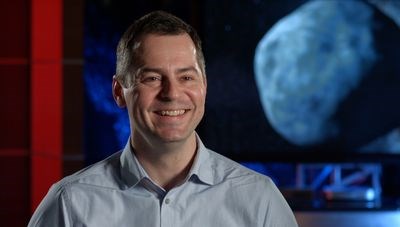A former Canora resident’s love of video games and science fiction has encouraged him to follow his dreams and join the Canadian Space Agency, where he’s now taking part in the first mission that will bring asteroid material back to Earth.
Tim Haltigan, son of Linda Osachoff, is part of the team which will be launching the satellite Origins Spectral Interpretation Resource Identification Security Regolith Explorer (OSIRIS-REx) on September 8 in order to take a sample of matter from the asteroid Bennu. The satellite consists of a camera system named OCAMS, a thermal emission spectrometer named OTES, a visible and infared spectrometer known as OVIRS, an X-ray named REXIS, and the laser altimeter known as OLA, which Haltigan is the mission manager of.
The satellite will reach the asteroid in March of 2021 and use OLA to measure the shape and surface of the asteroid, which is 492 metres in diameter and spins like a top, according to Haltigan. The laser altimeter will take about a billion different measurements in order to find an area without boulders and ice floes. Once an acceptable spot is found, the satellite will extract part of the foundation of the boulder, and should return with the sample in September of 2023.
OLA is composed of approximately 4,000 mechanical parts, 3,000 electric parts, and 30 optical parts while using 75 watts of power. It uses a time-of-flight system to take measurements of the asteroid, by shooting out a laser and measuring the time it takes for the pulse to go from OLA to Bennu and back to OLA. By shooting out pulses at areas no more than nine centimetres apart, the satellite can create a map of the asteroid’s topography.
Halitgan said he was “extremely excited” to be part of such a complex mission during a virtual briefing on August 25.
“Entire careers can be made on the understanding of a single grain of the asteroid,” he said, adding that this solidifies Canada’s expertise in robotics and science and thanking the many people around the country who helped complete the satellite
Haltigan’s route to joining the Canadian Space Agency was not at all straight-forward, he said. He lived in Canora for his childhood, but after graduating from Canora Composite School, he moved to Montreal, Que. in order to study biochemistry at McGill University. His research focused on the study of malaria. He eventually decided to switch degrees to geography, and studied rivers and trout habitats.
While completing his master’s degree, some friends of his entered a contest held by the European Space Agency. Teams were instructed to determine how scientists could find water on Mars, and Haltigan’s friends asked him to join in. Their team eventually travelled to Barcelona, Spain for the finals, and the professor organizing the team asked Haltigan if he’d like to persue a PhD on the nature of Mars.
Haltigan’s research led him to make nine expeditions to the Arctic Circle in order to compare the conditions of the land and climate to Mars. The expeditions were funded by the Canadian Space Agency, which allowed him to make contact with people involved in space research, and just before graduating, he decided to apply for work in the agency.
“There was a job posting for a researcher, and I applied. I think I started working there six days after I graduated, so it was pretty fast,” he said.
After two years, Haltigan became a program scientist. “I plan future programs and sort of get a big picture model about what we need to make for missions.”
He is now the scientist in charge of the overall operations of the laser altimeter OLA and the organizing scientists.
When asked what in particular he finds most exciting about the OSIRIS-REx mission, Haltigan sounded ecstatic.
“We’re firing lasers at an asteroid! It’s like something out of science fiction, but it’s actually what I do for a living.”
He said that it is easy to get bogged down in the usual workplace duties of taking phone calls, filing paperwork, and attending meetings, but when he stops to think about what he’s actually accomplishing, it is “incredibly exciting.”
His work with the Canadian Space Agency can be complicated, he said, adding that this is the first flight project he worked on.
“I didn’t realize what I was getting into. Sometimes the smallest thing can take days of time and whole teams of people. It was an incredible learning experience, realizing how much work goes into it.
“I always knew that I wanted to work in the space industry,” he said when asked about how he reached his goals. “I would tell people following their dreams to honestly just work hard and be nice to people.
“One opportunity leads to another. My journey was a winding path, but I believed that there would be an opportunity to do what I wanted at the end of it.”
When asked to offer advice, he said that “luck is a combination of opportunity and preparedness.
“Opportunities open up, and you have to be ready for when those opportunities come,” he said.
Haltigan was glad to have his childhood dreams come to life through the Canadian Space Agency and the OSIRIS-REx project.
“I grew up playing video games about shooting lasers at asteroids, and now it’s my job to shoot lasers at asteroids. It never stops amazing me.”



